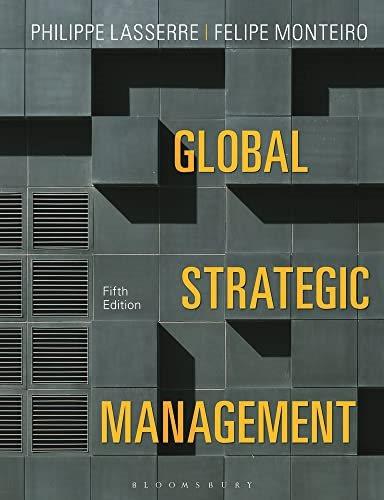Lubricador SA is an Italian specialist chemical company with a wide range of products serving various industrial
Question:
Lubricador SA is an Italian specialist chemical company with a wide range of products serving various industrial applications. The car division of the company specializes in lubricants for brake and air-conditioning systems. In late 2020, the company sent a mission to China to analyse the market and prepare an analysis of various investment alternatives.
China had become the second largest car market in the world and was on the way to full recovery after the pandemic crisis of 2020. The Chinese car industry was extremely competitive, with local as well as international players fighting for market share. The study team had concentrated on one particular type of product: brake fluid additive.
It estimated that the current domestic market of 50 million litres a year would grow at a rate of 8 per cent a year over the decade from 2020 to 2030.
The competition was made up of two domestic firms which controlled 70 per cent of the market and one Japanese joint venture which controlled 30 per cent. The study team concluded that there were four major alternatives for market entry:
● Set up a greenfield operation and operate as a 100 per cent subsidiary. The minimum economic capacity was 20 million litres for a total investment of $20 million. The financing of the investment would be done entirely by the mother company and it could expect to repatriate a dividend of 80 per cent of net profit when this became positive.
The subsidiary could not expect to capture more than 10 per cent of market share in the first year, growing progressively by 5 per cent a year and stabilizing at 20 per cent after the fifth year of operations. Export output would be around 5 million litres in the first year, increasing by 0.5 litres per year up to 8 million litres.
● The second alternative was to buy the Japanese competitors. The acquisition price would be
$70 million but Lubricador could expect to capture the 30 per cent market share right away. The yearly growth and export output, as compared with the first alternative, would be the same. An additional investment of $10 million might be needed for an additional 10 million litres. Dividends would be 90 per cent of net profit.
● A third option would be to form a joint venture with one existing Chinese firm. The immediate market share would be 30 per cent, rising to 50 per cent in the third year owing to the improved technology of the Italian firm. The total investment cost would be $30 million. The financing of the joint venture would be one-third equity to be shared 50/50 with the local partner and two-thirds debts to be serviced over seven years. The maximum exports in that case would only be 6 million litres per year. All other hypotheticals would remain the same.
● Finally, it was possible to conclude a licensing agreement with a local firm which could use and transform its existing facilities and obtain, at best, a 20 per cent market share. In such a case, Lubricador SA would have to invest $600,000 over the next three years to transfer its technology and receive a royalty of 3 yuan/Ltrs after three years.
Questions:
1 What are the economic benefits for Lubricador in each option?
2 Beyond the return, what are the advantages and disadvantages of each option?
3 Which option would you select and why?
Step by Step Answer:

Global Strategic Management
ISBN: 9781350932968
5th Edition
Authors: Philippe Lasserre, Felipe Monteiro





